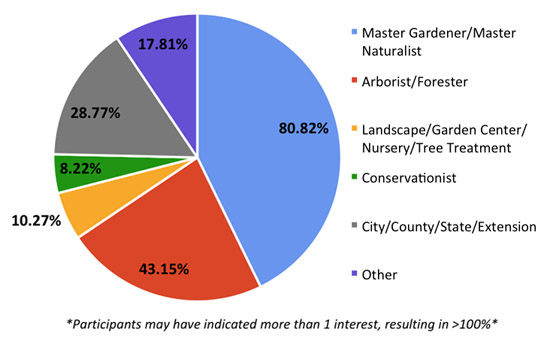Issue 2, May 6, 2013
2012 First Detector Wrap Up
The 2012 First Detector Training Workshops are officially in the books. We received a tremendous amount of interest in this inaugural workshop series. Many of the workshops were filled to capacity and the enthusiasm at all seven events was terrific.
For those that might be unaware of this program, the first detector workshops this past winter focused on invasive tree pests. The goal was to provide in depth training sessions on emerging and current invasive insects, pathogens, and plants. Training in 2013 focused on emerald ash borer, thousand cankers disease, and three invasive plants--giant hogweed, Japanese stiltgrass, oriental bittersweet, mile a minute weed, princesstree, and Japanese chaff flower (depending on the location of the event). In addition to presentations by state experts covering identification, biology, hosts, sampling, management, look-a-likes, and regulation on each pest, participants also completed hands-on activities to put their new knowledge to work.
Statewide, 324 individuals completed first detector training in 2012. At each workshop, participants were asked to complete an evaluation form which consisted of a few questions to help us plan for future workshops as well as asking what their profession/interest was to help classify our audience. Participants were also asked to rate their degree of understanding of the presented material before and after training using a 1 to 5 scale (1= very little, 5 = a lot). About 70% of participants returned evaluation summaries.
Participants:
Number* |
Profession/Interest |
|---|---|
82 |
Master Gardener |
36 |
Master Naturalist |
63 |
Forester/Arborist |
15 |
Lawn Care/Landscape/Garden Center/Nursery |
12 |
Conservationist |
29 |
City/County Employee |
13 |
Extension/Government |
16 |
Homeowner |
4 |
Business Owner (Tree Treatment/Consulting) |
1 |
Journalist |
5 |
Non Profit |

Degree of Understanding/Knowledge Gained:
Participants were asked to rate their degree of understanding of the presented material before and after training using a 1 to 5 scale (1 = very little, 5 = a lot)
Emerald Ash Borer |
Before Training (Average) |
After Training (Average) |
% Change in Knowledge |
|---|---|---|---|
Identification/Detection |
3.27 |
4.46 |
+ 36.3% |
Life cycle/Biology |
2.96 |
4.27 |
+ 44.2% |
Hosts |
3.36 |
4.40 |
+ 30.1% |
Sampling |
2.79 |
4.24 |
+ 52.1% |
Management |
2.93 |
4.31 |
+ 46.8% |
Look-A-Likes |
2.70 |
4.17 |
+ 54.4% |
Regulation |
2.81 |
4.15 |
+ 47.9% |
Thousand Cankers Disease |
Before Training (Average) |
After Training (Average) |
% Change in Knowledge |
|---|---|---|---|
Identification/Detection |
1.62 |
4.01 |
+ 147.6% |
Life cycle/Biology |
1.59 |
3.98 |
+ 150.7% |
Hosts |
1.84 |
4.16 |
+ 126.5% |
Sampling |
1.61 |
3.96 |
+ 145.7% |
Management |
1.54 |
3.87 |
+ 152.9% |
Look-A-Likes |
1.65 |
3.84 |
+ 132.8% |
Regulation |
1.51 |
3.91 |
+ 158.3% |
Invasive Plants |
Before Training (Average) |
After Training (Average) |
% Change in Knowledge |
|---|---|---|---|
General knowledge |
2.44 |
4.17 |
+ 71.3% |
Secondary Audience:
Participants were asked to indicate the number of people they encounter in regards to tree care. This number could be utilized to project how information learned during the first detector training might be disseminated and how many people this information may potentially reach.
Number of Participants |
Potential Secondary Audience |
|---|---|
99 |
0 to 50 |
40 |
51 to 100 |
34 |
101 to 500 |
16 |
501 to 1000 |
10 |
1000 + |
Needless to say, we are very excited about the future of this program. We are in the planning stages for the 2014 workshops. Stay tuned for updates about where they will be and what we will be covering. We look forward to seeing you there! (Kelly Estes and Stephanie Porter)
Authors:
Kelly Estes
Stephanie Porter